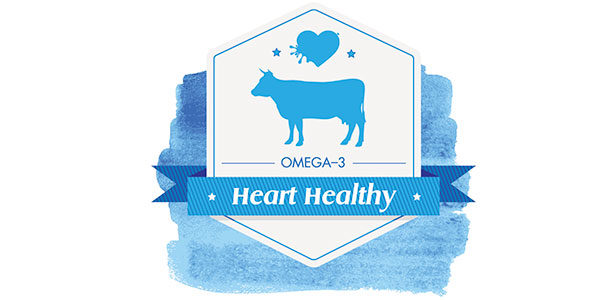Conventional and organic dairy producers are seeking ways to add value to their product, and there is a growing consumer movement toward healthier foods. Adding flaxseed to a dairy cow’s diet may be a way to meet both those desires, according to André Fonseca de Brito. Brito is a veterinarian, Ph.D. and assistant professor of organic dairy management at the University of New Hampshire.
“Including ground flaxseed as a dietary component for organically managed cows may have a threefold benefit of providing a nutritionally enriched product to the consumer, increasing profitability for the farmer and reducing enteric methane production, thus minimizing the impact of dairy systems on the environment,” Brito said.
Milk that is rich in omega-3 fatty acids and conjugated linoleic acid (CLA) is potentially more heart-healthy than typical milk available to consumers, but there is much yet to be learned about how to best increase those fatty acids.
Brito shared the results of a study of the effects on milk when feeding flaxseed to cows at the Midwest Organic & Sustainable Education Service (MOSES) Organic Farming Conference held this spring in LaCrosse, Wisconsin.
Healthy fatty acids such as omega-3 and CLA exhibit potential beneficial health effects for humans including being anti-carcinogenic, essential for growth and development, and beneficial to the cardiovascular system.
Flaxseed contains high levels of omega-3 fatty acids, which are transferred to milk fat. Feeding flaxseed also increases the concentration of CLA in milk, Brito explained.
“Milk fat is the most variable component in milk, and feeding flaxseed provides a unique opportunity to match milk fatty acid composition to benefit human health,” he said.
The milk from cows fed on pasture naturally has more omega-3 than from cows fed a TMR. Because the composition of pastures varies throughout the grazing season and in many areas of the U.S., and cows do not have access to pasture in the winter, studies are focusing on other ways of keeping those levels elevated.
There have been several studies to improve milk omega-3 fatty acids and CLA through flaxseed supplementation and extension of the grazing season as part of a four-year project funded by the USDA-NIFA-Organic Agriculture Research and Extension Initiative.
Brito and his colleagues found that “feeding flaxseed to organic dairy cows during the winter and summer seasons provides both exciting opportunities and major challenges for organic dairy farmers.”
The winter study results showed a positive impact of flaxseed on changing milk fatty acid profile toward more omega-3 and CLA, particularly in higher levels of dietary inclusion (i.e., 10 to 15 percent flaxseed). But milk production went down linearly in organic dairy cows fed flaxseed during the winter months, as well as fat-corrected milk, energy-corrected milk and dry matter intake.
Brito reports milk production averaged 46.7, 46.3, 45.4 and 43.9 pounds per day for cows receiving 0, 5, 10, and 15 percent flaxseed, respectively.
“Linear reductions in the yields of milk components are explained by the linear decline in milk production; the observed linear decrease in milk urea nitrogen (MUN) was associated to intake of crude protein, which also exhibited a linear decline (from 6.8 to 6.5 pounds per day) in cows fed incremental levels of ground flaxseed,” he said. “It is important to note that the diet with 15 percent flaxseed resulted in the poorest production of milk and milk components.”
The amount of milk CLA increased linearly by the amount of flaxseed fed in organic dairy cows during the winter months. The amount of saturated fatty acids decreased (considered a “bad fat” in foods consumed by humans) and milk monounsaturated fatty acids and polyunsaturated fatty acids (both considered “good fats”) found in milk increased linearly with incremental levels of ground flaxseed.
Perhaps the bottom line right now is that income over feed costs declined with increasing the dietary levels of ground flaxseed. Brito noted in the future there may be enough consumer demand to warrant a premium on milk with higher omega-3 and CLA, which could mean more profitability for dairy producers.
Another positive response found in the study was the reduction in methane emissions when flaxseed was fed in higher amounts during the winter season.
“Diets supplemented with flaxseed, particularly when it is ground, also offer a unique opportunity to mitigate methane emissions in dairy cows. Methane from ruminant animals, particularly cattle, has been cited as the second- largest source of methane emissions in the country,” Brito said. “Methane is a potent greenhouse gas directly tied to global climate change.
In addition, methane production represents a 2 to 12 percent loss in animals’ energy intake, which varies based on the level of feed intake and composition of the diet. In general, pasture-based or high forage-based diets often lead to higher levels of methane production as compared to high grain-based diets or diets containing feeds rich in oil.”
Brito concluded, “Based on our collective results so far, it appears that 10 percent of dietary inclusion of ground flaxseed is the best compromise. We will be able to provide a more solid recommendation as more results from our grazing study emerge.
The major determinants of flaxseed adoption in organic dairy farms will be the cost of flaxseed supplementation, future industry premiums for omega-3 and CLA-enriched milk, and potential niche markets for value-added organic dairy products.” PD
Kelli Kaderly-Boylen is a freelancer based in northeast Iowa.
Illustration by Kristen Phillips.






